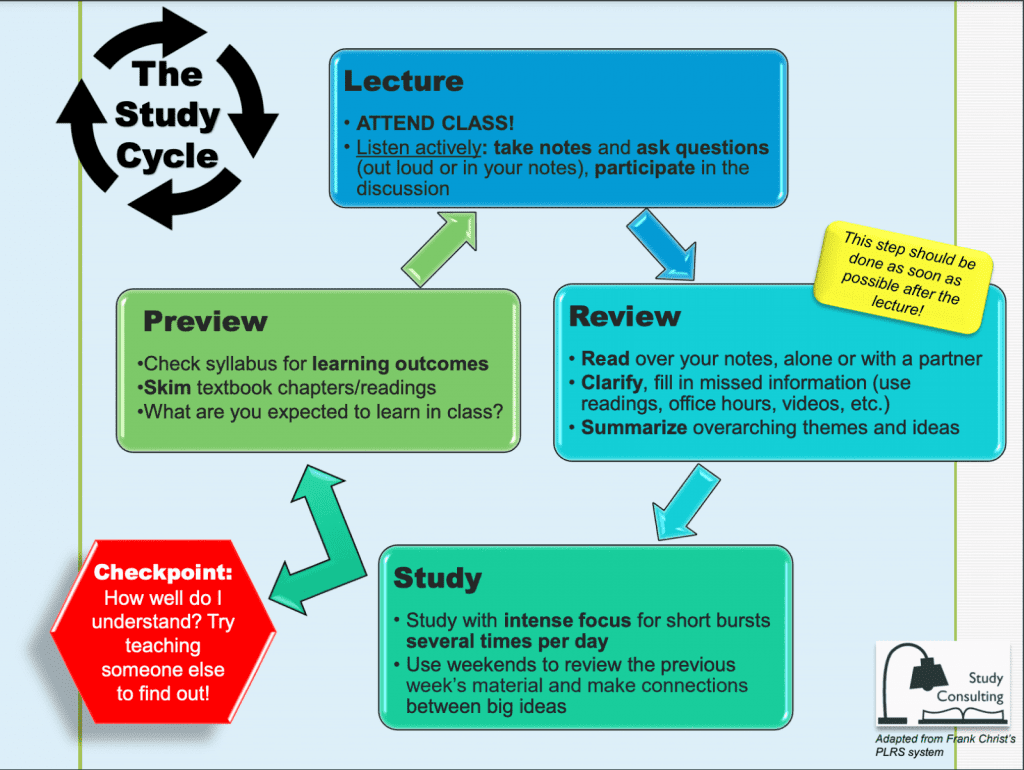We all have our preferred ways of studying. Perhaps you already have a tried and tested study routine, and you’re comfortable with how it works. Or maybe you’re realizing your habits from high school aren’t as effective anymore and you’re hoping to change your study routine. Here, we’ll be introducing a highly effective and simple system called Study Cycle.

Preview
The syllabus can be a very helpful tool in your study process. It’s not just a handout to check for the class’s grading policy. Professors also post learning objectives and reading materials on the syllabus so students can be prepared for the lecture. Take a look at the topics in the textbook the night before class. This doesn’t have to be an in-depth preparation. It can be a little as 10 minutes. The goal is for you to familiarize yourself with the material so you can follow along better in the lectures. Sometimes the immediate benefit of preview may not be apparent, but be patient with it. Over time, you’ll become better at predicting important information that the professor will cover (given that you attend lectures).
Lecture
All that work you’ve done previewing will be wasted if you don’t go to class. You’re halfway there just by physically being in the classroom, but it goes without saying that you should pay attention in class. So, what are some things you can do to fully engage with the material? For lecture-based classes, taking good notes is a crucial step for you to organize the lecture content. Our memory is very limited and it’s unlikely that you will remember everything from class when you’re reviewing or studying. As a bonus, note taking helps you stay focused in class and keep you away from distractions.
In smaller, discussion-based classes, a good habit is to actively participate in discussions. Not only does class participation factor into your grade, you’ll also get more out of the class.
Review
Most people tend to neglect this step, but it supplements the lecture perfectly. Reviewing works best when it immediately follows the lecture, and it doesn’t take up much time. You can start by reading through your notes and reminding yourself what you just learned. Pretend you’re the professor. Teach the material to yourself or your friend in the class. Do you understand all the concepts or are there any confusions? It’s much easier to sort this out when your memory is fresh so you can find the relevant help. This can be textbook reading, online videos, or office hours.
Study
The most effective study method is to have several study sessions throughout the day and week. You may see people sitting in the same spot in the library for hours and even the whole day studying, but the fact is we lose our focus easily this way. Short study sessions are more efficient and allows you to focus better on the target subject. How to organize these sessions are up to you, depending on the content difficulty, the exam date, and so on.
Weekends are the perfect window to get in as much studying as possible. During these study sessions, you can start by reviewing the previous week’s content. Only by understanding all the foundational material can you perform well on midterms. Remember to combine with other active learning techniques to make the most of studying sessions.
Checkpoint
Before going back to the preview step, take some time to check if everything is working well as planned. Are you doing enough previewing for class? Is there anything more you can do in lecture to help your understanding? How effective are the study sessions? Adjust accordingly, as we all learn and study differently. A good way to test for understanding is to teach someone else.
Don’t hesitate to reach out to the Study Consulting Program if you need help getting down the study cycle routine.